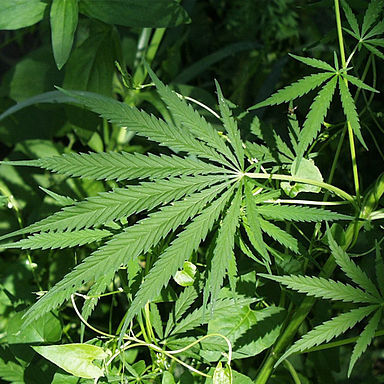Erect annual aromatic herb. Leaves alternate, or opposite at the base of the stems, palmately divided into narrow leaflets; stipules linear, acute. Male flowers numerous, shortly pedicellate, in lax drooping terminal and axillary panicles; tepals free, oblong, spreading or reflexed; anthers at length pendulous. Female flowers fewer, in short erect spikes, leafy below, each flower sessile in the axil of an enveloping bracteole and also with a stipule-like bract; perianth inconspicuous, very thin, closely enveloping the ovoid ovary. Fruit ovoid, compressed with seed closely conforming to the thin crustaceous pericarp. Embryo strongly curved; cotyledons fleshy.
Herbs, annual, erect, dioecious or sometimes monoecious. Stems furrowed. Leaves alternate or opposite basally on stem, palmately compound, basally with 5-11 leaflets, apically with 1-3 leaflets; leaflet margin serrate. Male inflorescences axillary or terminal, a lax panicle. Male flowers: sepals imbricate; filaments straight in bud; rudimentary pistil small. Female inflorescences axillary, in a rosette. Female flowers: bracteoles leaflike; calyx rudimentary, membranous, appressed to ovary; styles 2, linear, caducous. Achene solitary, surrounded by persistent calyx, enclosed by bracts; endosperm fleshy; embryo curved; cotyledon fleshy.
Female inflorescences short, compact, not exceeding the leaves; flowers fewer, paired, each subtended by a stipule-like bract and a small green “bracteole” or “calyx” which completely envelopes the ovary and loosely encloses the mature fruit, this enveloping bracteole forming a basally swollen tubular sheath narrowly attenuate at the apex and covered with fine hairs and shortly-stalked or sessile, resinous glands; perianth membranous, undivided, tightly enveloping the ovary and mature fruit (often reduced or absent in cultivated forms), marbled with light and dark areas; stigma-branches densely pubescent, caducous.
Herbs , annual, erect, taprooted. Stems simple to well branched, without 2-branched hairs. Leaves palmately compound; petiole not twining, without 2-branched hairs. Leaf blade: surfaces abaxially sparsely to densely pubescent. Inflorescences: staminate inflorescences compound cymes or panicles, erect; pistillate pseudospikes, congested, erect to spreading. Flowers: staminate and pistillate on different plants, sometimes on same plants, especially in cultivars. Achenes lenticular, enclosed within enlarged perianth; embryo curved. x = 10.
Ordinarily dioecious; pistillate fls in small clusters on short, leafy branches from the upper axils, each fl semi-enclosed by a closely subtending, abruptly acuminate bract; cal short and barely lobed, or sometimes longer but hyaline and becoming adnate to the pericarp; fr a thick-lenticular achene, with a closely subtending accrescent bract; erect annual herbs; lvs petiolate, the principal ones palmately compound with 5–9 lfls, commonly opposite, the upper smaller, usually alternate, with fewer lfls or undivided. Monospecific.
Erect annual aromatic herbs, dioecious with male and female plants dimorphic, or rarely monoecious; indumentum of most parts consisting of minute appressed sollen-based hairs; leaves alternate or opposite at the stem base, palmately loheb or digitately compound, leaflets uneven in size, with serrate margins; stipules lateral, persistent.
Erect annual. Lvs alternate or the lower opposite, palmately compound; leaflets narrowly elliptic to lanceolate, serrate. Infls erect; ♀ infl. racemose with fls crowded in the axils of foliaceous bracts. Achene ± enclosed by membranous perianth; embryo curved; cotyledons thick, fleshy.
Male inflorescences laxly cymose-paniculate, bristly-hairy, exceeding the leaves but bearing a few scattered leaves; flowers numerous, shortly pedicellate; perianth lobes free, boat-shaped, spreading or reflexed; stamens pendulous at maturity, filaments short; pistillode 0.
Erect branching herbs, dioecious or occasionally both sexes intermixed on the same plant. Stems ribbed. Leaves with 3–9 leaflets, palmate, the lower opposite, upper alternate. Male inflorescence paniculate, erect; female inflorescence spicate, erect.
Fruit a globular to ovoid achene tightly covered by the thin crustaceous perianth, the reticulate venation of the surface visible beneath the perianth.
Easily identified by the light and dark patterning of the perianth layer (where this is present) surrounding the fruit.
Leaves alternate or opposite, palmately divided
Embryo strongly curved, cotyledons fleshy.
Achene covered by the persistent calyx
Embryo curved.
Stem erect

